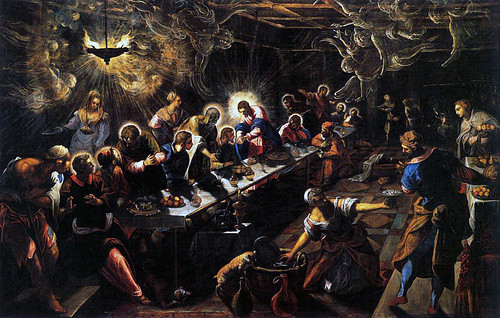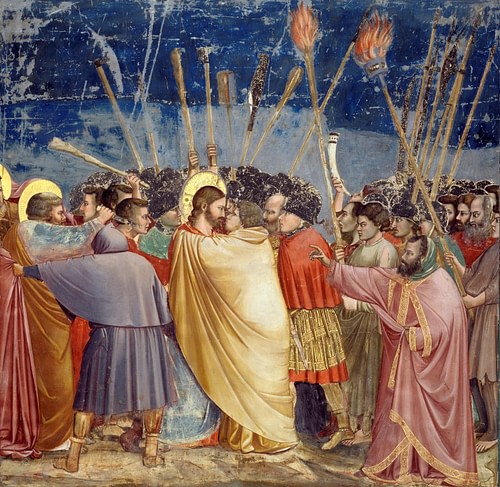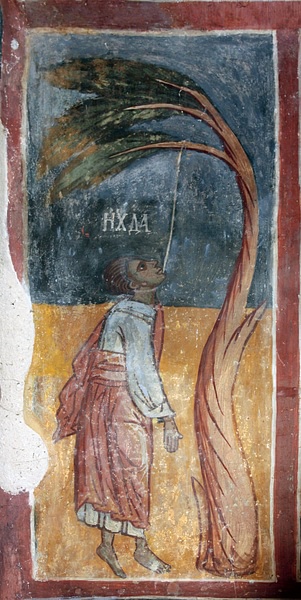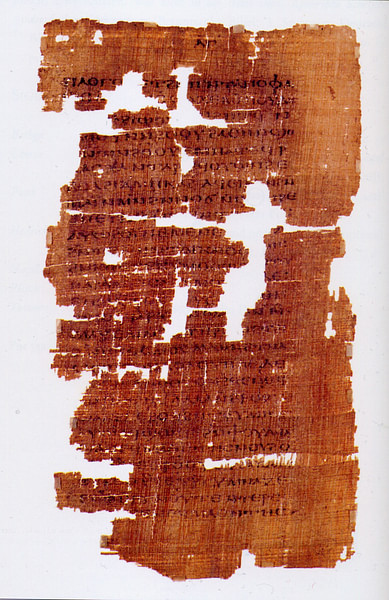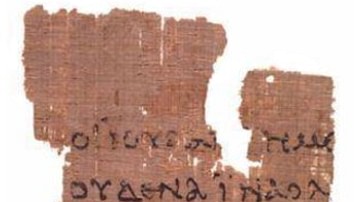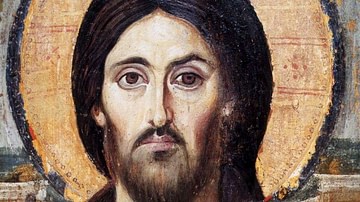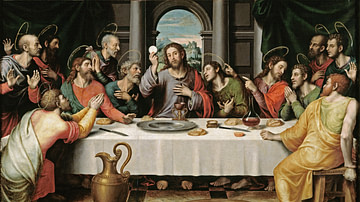
Judas Iscariot was one of the original disciples of Jesus of Nazareth (d. c. 30 CE), one of the twelve apostles. For handing Jesus over to the authorities, as described in the gospels, he has become the epitome of the act of betrayal in the Christian tradition, eternally beyond forgiveness. For this reason, few would name a son Judas in the modern era. It was, however, a very popular name in the 1st century CE. 'Judas' was the Greek for the Hebrew name 'Judah' (meaning "God is thanked"), reflecting Judas Maccabeus and his successful Maccabean revolt against Greek rule (167 BCE). The epithet 'Iscariot' remains subject to scholarly debate. It could refer to "being from Kerioth", a village south of Jerusalem, or it could indicate the manner of his death: iskarioutha could mean 'chocking' or 'constriction.'
The story of Judas first appeared in Mark’s gospel (c. 70 CE). We can find no earlier evidence of a story of betrayal or this individual. Matthew, Luke, and John all copied Mark, but with their own editing, traditions, and details. These are not four independent sources for Judas. Where and how Mark received his information remains unknown. Analysis of the gospels is difficult because, like other Jewish sects in the 1st century CE, to validate an argument, the gospels writers turned to the Scriptures, the stories and traditions of Israel. Just as they demonstrated that Jesus and his ministry fulfilled the Scriptures, so too, the same principle was applied to the character and activity of Judas.
Judas the Apostle
Jesus called his disciples, designated as "the twelve". This is symbolic of the restored twelve tribes of Israel when God would establish his kingdom according to the message of Jesus. In the list of the disciples, Judas is last, with the added "Judas Iscariot, who betrayed him" (Mark 3:19). The reader knows from the very beginning what Judas is going to do. Despite this, in Mark, Judas works in tandem with the rest of the disciples throughout the ministry. Jesus sends them out in pairs with "authority over impure spirits" and to anoint people with oil to cure them (6:7). In Mark, Matthew and Luke, we hear nothing specific about Judas until the events in Jerusalem.
The gospel of John (c. 100 CE) related a role for Judas, "keeping the money box", which was a trusted position. This detail is found in the passage when Jesus was at the house of Lazarus, and his two sisters, Mary and Martha:
Then Mary took about a pint of pure nard, an expensive perfume; she poured it on Jesus’ feet and wiped his feet with her hair ... But one of his disciples, Judas Iscariot, who was later to betray him, objected, "Why wasn’t this perfume sold and the money given to the poor?" ... He did not say this because he cared about the poor but because he was a thief; as keeper of the money bag, he used to help himself to what was put into it. "Leave her alone," Jesus replied. "It was intended that she should save this perfume for the day of my burial. You will always have the poor among you, but you will not always have me. (12:1-8)
Judas & the Jewish Authorities
The betrayal story, as mentioned above, first appears in Mark. In 1 Cor. 11:23, Paul mentions how Jesus was "handed over" to the authorities, but the Greek word here does not mean "betrayed" even though it is usually translated so because the story of Judas is thoroughly embedded in Western tradition.
Then Judas Iscariot, one of the Twelve, went to the chief priests to betray Jesus to them. They were delighted to hear this and promised to give him money. So he watched for an opportunity to hand him over. (Mark 14:10-11)
Matthew provided a dialogue, too:
"What are you willing to give me if I deliver him over to you?" So they counted out for him thirty pieces of silver. (Matthew 26:15)
30 pieces of silver was the value in compensation for an injured slave. In Zechariah 11:12-13, Zechariah received 30 pieces of silver for his work as a shepherd, at which he failed. Zechariah then threw the money at a potter, and Matthew may have used this motif in association with his description of Judas’ death.
Luke (and John) provided a different motivation:
Then Satan entered Judas, called Iscariot, one of the Twelve. And Judas went to the chief priests and the officers of the temple guard and discussed with them how he might betray Jesus. They were delighted and agreed to give him money. He consented, and watched for an opportunity to hand Jesus over to them when no crowd was present. (Luke 22:3-6)
The Last Supper
When evening came, Jesus arrived with the Twelve. While they were reclining at the table eating, he said, "Truly I tell you, one of you will betray me—one who is eating with me." They were saddened, and one by one they said to him, "Surely you don’t mean me?" "It is one of the Twelve," he replied, "one who dips bread into the bowl with me. The Son of Man will go just as it is written about him. But woe to that man who betrays the Son of Man! It would be better for him if he had not been born." (Mark 14:17-21).
Matthew added: "Then Judas, the one who would betray him, said, "Surely you don’t mean me, Rabbi?" Jesus answered, "You have said so"" (26:25). In Luke: "But see, the one who betrays me is with me, and his hand is on the table. For the son of man is going as it has been determined, but woe to that one by whom he is betrayed! Then they began to ask one another which one of them it could be who could so this (22:21).
In narrative terms, these passages are somewhat confusing. The reader knows that it is Judas, but apparently, none of the disciples knew. In scriptural terms, elements of the Psalms of lament were integrated throughout the passion narrative of Jesus. This scene is related to Psalm 41:9: "Even my close friend, someone I trusted, one who shared my bread, has turned against me."
John’s gospel provides a more credible plot structure:
"Very truly I tell you, one of you is going to betray me." His disciples stared at one another, at a loss to know which of them he meant. One of them, the disciple whom Jesus loved, was reclining next to him. Simon Peter motioned to this disciple and said, "Ask him which one he means." Leaning back against Jesus, he asked him, "Lord, who is it?" Jesus answered, "It is the one to whom I will give this piece of bread when I have dipped it in the dish." Then, dipping the piece of bread, he gave it to Judas, the son of Simon Iscariot. As soon as Judas took the bread, Satan entered into him. So, Jesus told him, "What you are about to do, do quickly." But no one at the meal understood why Jesus said this to him. Since Judas had charge of the money, some thought Jesus was telling him to buy what was needed for the festival, or to give something to the poor. As soon as Judas had taken the bread, he went out. (John 13:21-30)
Luke has the same story, but without naming Judas. After dinner, Jesus and the disciples walk over to Gethsemane ('olive press') at the foot of the Mt. of Olives. The scene at Gethsemane has a fascinating parallel in the story of Ahitophel, a courtier of David during Absalom’s rebellion:
Let me choose twelve thousand men, and I will set out and pursue David tonight. I will come upon him when he is weary and discouraged and throw him into a panic; and all the people with him will flee. I will strike down the king only. You seek the life of only one man, and all the people will be at peace. (2 Samuel 17:1-4).
David had sought refuge on the same Mt. of Olives, weeping. After the failure of the rebellion, Ahitophel hung himself.
The Kiss of Judas & the Arrest of Jesus
Mark relates Jesus' arrest:
... Judas, one of the Twelve, appeared. With him was a crowd armed with swords and clubs, sent from the chief priests, the teachers of the law, and the elders. Now the betrayer had arranged a signal with them: "The one I kiss is the man; arrest him and lead him away under guard." Going at once to Jesus, Judas said, "Rabbi!" and kissed him. The men seized Jesus and arrested him. (Mark 14:43-46)
The Scriptural reference here could be Proverbs 27:6: "Faithful are the wounds of a friend, but the kisses of an enemy are deceitful." This Judas kiss became a metaphor of betrayal in art and literature.
When Judas, who had betrayed him, saw that Jesus was condemned, he was seized with remorse and returned the thirty pieces of silver to the chief priests and the elders. "I have sinned," he said, "for I have betrayed innocent blood." "What is that to us?" they replied. "That’s your responsibility." So Judas threw the money into the temple and left. Then he went away and hanged himself. The chief priests picked up the coins and said, "It is against the law to put this into the treasury, since it is blood money." So they decided to use the money to buy the potter’s field as a burial place for foreigners. That is why it has been called the Field of Blood to this day. Then what was spoken by Jeremiah the prophet was fulfilled: "They took the thirty pieces of silver, the price set on him by the people of Israel, and they used them to buy the potter’s field, as the Lord commanded me." (Matthew 27:3-10).
There is no such prophecy in Jeremiah, and Matthew (or a later scribe) most likely confused this with the Zechariah quote mentioned above because both prophets mentioned potters.
In Acts of the Apostles, Luke recounted Judas' death in the story of the Matthias replacing Judas, to restore the twelve:
(With the payment he received for his wickedness, Judas bought a field; there he fell headlong, his body burst open and all his intestines spilled out. Everyone in Jerusalem heard about this, so they called that field in their language Akeldama, that is, Field of Blood.) "For," said Peter, "it is written in the Book of Psalms: 'May his place be deserted; let there be no one to dwell in it,' and, 'May another take his place of leadership.' " (Acts 1:18-20).
The Historical Judas
Many scholars accept the story of Judas as he fits into the criterion of 'embarrassment.' In other words, the traditions surrounding Judas must have been known because none of the gospels attempted to cover it up. An additional argument is that a betrayal story was not necessary to get Jesus to the cross. In Jerusalem during Passover, the priesthood, as well as the Roman army, would be alert to anyone with a following, preaching a kingdom that was not Rome. The story of Judas, then, appears as something extraneous and therefore had to be explained.
Without Judas, Jesus would not have died as an atoning sacrifice. Scholars and theologians debate what motivated Judas, often involving attempts to psychoanalyze him. He is often described as a member of the revolutionaries, the Zealots. When Jesus did not call for a revolt against Rome, in his disappointment, he turned him over to the authorities.
Part of the debate involves the motivation of Jesus. Jesus knew he was going to die; he predicted it throughout the ministry. Did he deliberately choose Judas for his role in "handing him over"? In this sense, is it fair to blame Judas when the death had already been determined? Or is the story of Judas an after-the-fact rationalization of a historical act of betrayal?
A minority view holds that Judas is not a historical character, but symbolic of the Jews who rejected Jesus as 'messiah'. However, there are other people named Judas in the New Testament, who have positive attributes: Jesus' brother Jude (Judas), the prophet, Judas Barsabbas (Acts 15:22-33), and John also mentioned a Judas, not Iscariot, in one of his stories (John 14:22).
The Apocryphal Judas
Over the centuries, details concerning Judas accrued in “apocryphal” literature, which did not make the canon. Papias of Hierapolis (60-130 CE) in Expositions of the Sayings of the Lord, claimed that Judas received God’s wrath in his physical body. It became so bloated that he could not pass through streets without hitting the buildings. His eyes were so swollen that a doctor could not find them, his genitals swelled and were full of pus and worms. Judas finally killed himself, placing his insides on the ground, and even a hundred years later, people could not walk by and avoid the stench.
In the Gospel of Nicodemus (c. 4th century CE), Judas, now feeling guilty, went home to his wife who was cooking a chicken. He told her he planned to kill himself because Jesus would rise from the dead and punish him. His wife laughed and said that Jesus could not rise from the dead, any more than this chicken could. The chicken was then restored to life and began to crow. Judas then ran and hanged himself.
Judas in Hell
The ancient world had a concept of 'noble death', where suicide was honored as an effort to remove shame. Augustine of Hippo (354-430 CE) however, made suicide a sin for Christians, and he was the theologian who trapped Judas in Hell for eternity. If Judas had not hanged himself, he could have been forgiven. His suicide placed him beyond all hope for reconciliation.
In Dante’s Inferno, Judas, along with Cassius and Brutus, are at the center of Hell, where the three-headed monstrous Satan devours them for eternity. Judas is the central figure, with his back clawed by the fallen angels.
The Gospel of Judas
In 2006 CE, the National Geographic Society announced the discovery and translation of The Gospel of Judas. Historians had been aware of a Gospel of Judas because a 2nd-century CE Church Father, Irenaeus, had written against it in his Adversus Haereses (Against Heresies). The Gospel of Judas is categorized as a Gnostic gospel, which portrayed Jesus in a totally different light than the canonical gospels in the 2nd century CE.
Most of this gospel consists of a dialogue between Jesus and Judas, where we learn that Judas is the only disciple who perceives who Jesus really is. This Gnostic Jesus was sent into the world to enlighten humans that salvation can be found through embracing the eternal God within themselves. Much of the dialogue between Jesus and Judas takes place while observing the eleven others. In almost mocking fashion, Jesus points out that the eleven can only perceive through the material senses, such as salvation found in martyrdom or believing in the resurrection of the body. In this gospel, Jesus tells Judas to betray him, so that he can return to the Father.
The Modern Judas
In 1970 CE, the rock-opera, Jesus Christ Superstar, by Tim Rice and Andrew Lloyd Webber opened on Broadway. The original cast had Ben Vereen as Judas, and the movie (directed by Norman Jewison) cast Carl Anderson in the role. Casting a black man as Judas, emphasized Judas as a sympathetic victim in the divine plan. In this version, Judas fears that Jesus’ preaching will get them all killed. When his pleas to Jesus has no effect, he goes to the priests to have Jesus arrested, but to spare the others . . . "For the sake of the nation, this Jesus must die." It ends with Judas descending from heaven after his suicide with a choir of angels. The final song by Judas indicates his continuing bewilderment:
Every time I look at you I don't understand
Why you let the things you did get so out of hand. . .
Jesus Christ, Jesus Christ,
Who are you? What have you sacrificed?
Jesus Christ Superstar,
Do you think you're what they say you are?
In 1988 CE, Martin Scorsese produced The Last Temptation of Christ, based upon the 1955 CE controversial novel of Nikos Kazantzakis. Both the novel and film present Jesus struggling with doubt and trying to resist God’s plan for him. Harvey Keitel was cast as Judas. In this version, Judas is a member of the Zealots who repeatedly tried to get Jesus to lead a revolution. There is a close relationship between Judas and Jesus, who convinces Judas to turn him over to the authorities so that he can obey God’s plan.
The last temptation occurs when Jesus is on the cross and is shown a vision of what his life would be like if he did not die. The future life includes marriage to Mary Magdalene and children. In the vision, an ageing Judas rebukes Jesus for the fact that Judas is now condemned by everyone, but for the wrong reason. If Jesus does not die, Judas cannot be understood for his part in salvation. In the end, Jesus decided to die.
